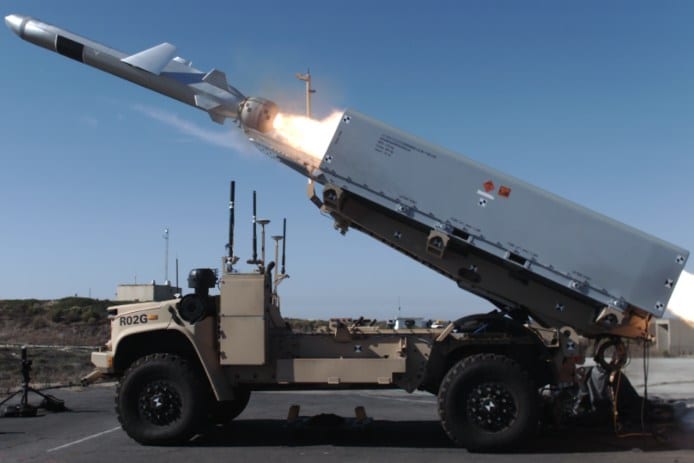
ARLINGTON, Va. — The vehicle-mounted Naval Strike Missile was highlighted by the Marine Corps’ commandant as an example of rapid development to meet the challenges of great power competition and enable the Corps to hold enemy naval units at risk from expeditionary bases.
While testifying April 29 before the defense subcommittee of the House Appropriations Committee, Gen. David H. Berger, commandant of the Marine Corps, held up a recently released photo of a Naval Strike Missile (NSM) being fired from a modified unmanned Joint Light Tactical Vehicle (JLTV) known as ROGUE.
The Navy Marine Expeditionary Ship Interdiction System, or NMESIS, successfully fired a Naval Strike Missile off the California coast, the system’s builder, Raytheon Missiles & Defense, a Raytheon Technologies business, said in an April 28 release. “The inaugural test proved the system’s ability to fire a Naval Strike Missile, or NSM, from a U.S. Marine Corps ground launcher and score a direct hit against a surface target at sea. The Marines will use NMESIS to support the U.S. Navy from the shore against enemy ships. NMESIS is comprised of the Raytheon Missiles & Defense-made NSM and a Remotely Operated Ground Unit for Expeditionary (ROGUE) Fires vehicle, produced by Oshkosh Defense.”
“Our Naval Strike Missile is a vital weapon for denying enemies the use of key maritime terrain,” said Kim Ernzen, vice president of Naval Power at Raytheon Missiles & Defense. “This test further demonstrates our partnership for advancing the Marine Corps’ modernization priorities of enabling sea control and denial operations.”
“Our role in contributing to [freedom of the seas] is, where [sea] denial, where [sea] control has to happen from a tactical to operational perspective, we can do that by moving the capability around that hold an adversary’s navy at risk from sip and from shore,” Berger said.
“This is the speed at which we have to develop a capability like that,” he said. “This is the brilliance of a couple of young officers and Oshkosh [Defense], and a few other people creating other capabilities long before they’re even thought all the way through. This Joint Light Tactical Vehicle is unmanned. The people at Oshkosh and these two [Marine Corps] majors thought, ‘We can do this.’ They took the cab off the back and they put [the NSM] on the back and a fire control system. Now we can move this around on vessels, put it ashore, and hold an adversary’s navy at risk in order to ensure that the lines of the sea are kept open.
“Our job is to support the fleet commander,” Berger said. “The fleet’s job is to support the joint force commander.”
Berger also said a benefit of the NSM is that it is common to the Navy and Marine Corps and can be shifted to where it is needed most.
- SECNAV Advocates Increased Legal Immigration to Increase Shipbuilder Workforce - April 23, 2024
- Insitu Going Strong at 30, Focusing on Maritime Operations - April 8, 2024
- Navy Awards Boeing Additional Funds for MQ-25 Drones for Testing - April 3, 2024




